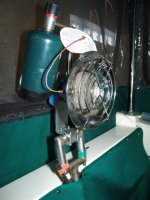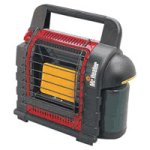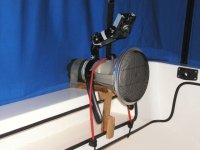Capital Sea":28jsvg81 said:
Yup, that CO falls to the floor like invisible water and fills up the boat till it spills over the lowest side wall. On my 22 this is several inches above the bed, though the boat does have a CO detector.
Most CO detector manufacturers recommend placing the CO detector above -- near the ceiling. Is it different in a boat? The clip below is an example:
"When considering where to place a carbon monoxide detector, keep in mind that although carbon monoxide is roughly the same weight as air (carbon monoxide's specific gravity is 0.9657, as stated by the EPA; the National Resource Council lists the specific gravity of air as one), it may be contained in warm air coming from combustion appliances such as home heating equipment. If this is the case, carbon monoxide will rise with the warmer air. For this reason, the makers of First Alert®, a leading brand in carbon monoxide detector technology, suggests mounting the detector on the ceiling. This also puts the detector out of the way of potential interference, such as pets or curious children."
(
http://www.homesafe.com/coalert/detect.htm)
See also:
"INSTALLING A CO DETECTOR: A FEW CONSIDERATIONS
One reason that ABYC may have been slow to recommend the use of CO detectors may be their reputation in the past for emitting unnerving false alarms periodically. You could almost count on a CO detector made prior to 1992, the older "single point" alarms, to sound whenever they detected even the slightest trace of CO. Since a whiff or two of CO is likely to drift into a cabin several times a day, the frequent alarms were an ongoing nuisance. After 1992, however, manufacturers began making more technically advanced units that use "time-weighted averaging" to greatly reduce the number of alarms. By averaging the CO over a period of a few minutes, these newer alarms will not sound unless they repeatedly detect CO. Some of the newer units can even do things like disengage the generator if CO is detected. A proper marine CO detector, incidentally, will have the UL 1524 marine mark, which means it was tested by Underwriters Laboratories standard 1524.
ABYC does not say where on the boat a CO detector should be located. The gas, which is about the same weight as oxygen, tends to dissipate evenly in an area and isn't any more likely to be found up near the ceiling or down by the cabin sole. As a practical matter, placing an alarm at eye level allows you to easily monitor any meters or warning lights on a unit. Sleeping areas, main saloons, an enclosed fly-bridge, and anywhere else people spend time are candidates for a CO detector. Areas that should be avoided include near hatches or doors where fresh air might distort readings. Dead air spaces-corners-should also be avoided."
(
http://www.boatus.org/onlinecourse/course_re-write/carbonmonoxide.html)



